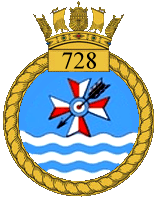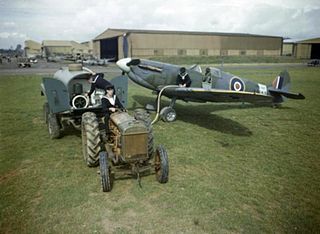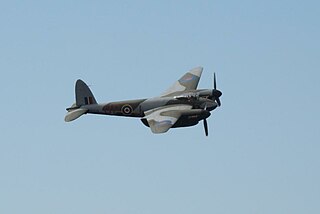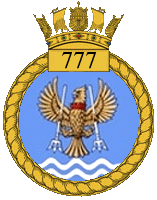
736 Naval Air Squadron was a Naval Air Squadron of the Royal Navy's Fleet Air Arm. It was most recently recommissioned at HMS Seahawk, RNAS Culdrose in June 2013 to fly the BAE Systems Hawk, mainly in the maritime aggressor role, following the disbandment of the Fleet Requirements and Aircraft Direction Unit (FRADU) and operated up until March 2022. It initially formed as the School of Air Combat in May 1943 at HMS Heron, RNAS Yeovilton. In September 1943 it moved to HMS Vulture, RNAS St Merryn, where it became the Fighter Combat School and it created an independent 'B' Flight for fighter affiliation work between March and September 1945. 736 Naval Air Squadron moved to HMS Seahawk, RNAS Culdrose in February 1950 as the Naval Air Fighter School in the 52nd Training Air Group, but disbanded in August 1952. Immediately the following day, the squadron reformed at HMS Seahawk, RNAS Culdrose out of 702 Naval Air Squadron as an Advanced Jet Flying School and in November 1953 it moved to HMS Fulmar, RNAS Lossiemouth. 736 Naval Air Squadron disbanded there in March 1965, but what was left became 764 Naval Air Squadron ‘B’ Flight. The squadron reformed the same day at Lossiemouth from 809 Naval Air Squadron as a Jet Strike Training Squadron. 1966. In March 1967, its aircraft were part of the group that bombed and set on fire the supertanker SS Torrey Canyon aground and leaking crude oil on Seven Sisters rocks off Cornwall. The squadron disbanded in February 1972.

887 Naval Air Squadron was a Naval Air Squadron of the Royal Navy's Fleet Air Arm, which last disbanded during March 1946. It was formed as a Fleet Fighter squadron in May 1942 at HMS Daedalus, RNAS, Lee-on-Solent. The squadron embarked in HMS Unicorn during 1943 for convoy escort duties and later in the year to cover the allied landings at Salerno, Italy. At the end of 1943 it formed part of the 24th Naval Fighter Wing. 1944 saw it embark in HMS Indefatigable and the squadron saw action in operations against the german battleship Tirpitz during early 1944 and then joined the British Pacific Fleet at the end of the year. It was part of the attacks on the oil refineries at Palembang at the start of 1945 and later in the year it was involved in sorties around Tokyo, as part of the 7th Carrier Air Group, before V-J Day.

719 Naval Air Squadron was a Naval Air Squadron of the Royal Navy's Fleet Air Arm. It initially formed in 1944 as a Fighter Air Firing Training Squadron, at HMS Vulture, RNAS St Merryn, within the School of Air Combat, but at the start of 1945 it disbanded into 794 Naval Air Squadron. The squadron reformed in 1946 at HMS Owl, RNAS Fearn, as a Strike Training Squadron, before moving to HMS Gannet, RNAS Eglinton, where it became an Anti-submarine Training Squadron, disbanding there in 1949. The squadron reformed the following year at HMS Gannet as the Naval Air Anti-submarine School and remained there becoming the Naval Anti-Submarine Operational Flying School, eventually disbanding in 1959. However, in 1960, the squadron reformed, again at HMS Gannet, as the Joint Anti-submarine School Flight, this time operating helicopters. 719 Naval Air Squadron was granted first line status on 5 October 1961 and renumbered to 819 Naval Air Squadron.

728 Naval Air Squadron was a Naval Air Squadron of the Royal Navy's Fleet Air Arm (FAA). It was formed at the beginning of May in 1943, as a Fleet Requirements Unit, at RN Air Section Gibraltar. It provided detachments at RN Air Section Tafaraoui, in Algeria and later at RAF Oujda in Morocco. Moving to HMS Grebe, RNAS Dekheila, in Egypt, during June, it then merged into 775 Naval Air Squadron during July. It reformed in August, again as a Fleet Requirements Unit, at HMS Grebe, moving immediately to RN Air Section Takali, Malta. It provided target towing both for the Royal Navy's Mediterranean Fleet and the British Army, before later providing a detachment to tow targets for the United States Navy at Naples, Italy. The squadron remained on Malta, alternating between the airbases at Ta Kali, Luqa and Hal Far, until disbanding at the latter, in May 1967.

746 Naval Air Squadron was a Naval Air Squadron of the Royal Navy's Fleet Air Arm which disbanded in January 1946. It formed initially as the Naval Night Fighter Interception Unit, in November 1942 at HMS Daedalus, RNAS Lee-on-Solent. It moved to R. N. Air Section Ford in December to join the RAF Fighter Interception Unit. The squadron came under the control of the Naval Fighter Direction Centre at HMS Heron, RNAS Yeovilton, in 1943 and was tasked with the development of tactics and analysis of the experiences of pilots from the carrier squadrons. It moved to RAF Wittering in May 1944, with a detachment at RAF Defford for radar development duties. In October the squadron returned to R. N. Air Section Ford and in January 1945, deployed 'A' flight to HMS Sparrowhawk, RNAS Hatston to provide ADDL, carrier deck landing training. 746 Naval Air Squadron became the Naval Night Fighter Development Squadron in May 1945, evaluating aircraft and their equipment, while detachments of pairs of aircraft were deployed aboard escort carriers after 'A' flight became an operational sub-unit.

748 Naval Air Squadron was a Naval Air Squadron of the Royal Navy's Fleet Air Arm. It was initially formed, at HMS Vulture, RNAS St Merryn, as a Fighter Pool Squadron, before becoming No. 10 Naval Operational Training Unit. The squadron moved to HMS Dipper, RNAS Henstridge, in February 1944 and then onto HMS Heron, RNAS Yeovilton in the March. In September 1944, 748 Naval Air Squadron moved to HMS Goldcrest, RNAS Dale, in Wales, remaining for just under twelve months, before moving back to HMS Vulture, RNAS St Merryn in August 1945, where it disbanded in February 1946. During its existence, the squadron was equipped with numerous aircraft and various marks, operated by the Fleet Air Arm.

759 Naval Air Squadron was a Naval Air Squadron of the Royal Navy's Fleet Air Arm. It was created on November 1, 1939, and was disbanded on December 24, 1969. It was initially intended as a Telegraphist Air Gunner Training Squadron but became a Fighter School and Pool Squadron in 1939, at RNAS Eastleigh. It operated out of RNAS Yeovilton from 1940 to 1946, as part of the Naval Air Fighter School. In 1943 a detachment operated out of RNAS Angle, working with 794 NAS and known as the Naval Air Firing Unit. It was again the Naval Air Fighter School upon reformation in 1951 and disbandment in 1954, firstly at RNAS Culdrose and then moving to RNAS Lossiemouth, in 1953. The squadron reformed again, this time at RNAS Brawdy in 1963, as the Naval Advanced Flying Training School, before finally disbanding in 1969.

761 Naval Air Squadron was a Naval Air Squadron of the Royal Navy's Fleet Air Arm. It was formed at HMS Heron, RNAS Yeovilton, as the Advanced Training Squadron of the Fleet Fighter School, in 1941. The squadron moved to HMS Dipper, RNAS Henstridge, in 1943, as part of the No. 2 Naval Air Fighter School. It remained at HMS Dipper and in this role, until January 1946, when the squadron disbanded.

762 Naval Air Squadron was a Naval Air Squadron of the Royal Navy's Fleet Air Arm (FAA). It formed at HMS Heron, RNAS Yeovilton, in March 1942 as an Advanced Flying Training School. Almost immediately the squadron relocated to HMS Vulture, RNAS St Merryn, but before the end of the year, it was back at HMS Heron. The squadron disbanded nine months later. It reformed in 1944 at HMS Daedalus, RNAS Lee-on-Solent, as a Twin Engine Conversion Unit, but immediately moved to HMS Goldcrest, RNAS Dale, where it operated a variety of multi engined aircraft. At the end of 1945 the squadron moved to HMS Sparrowhawk, RNAS Halesworth and HMS Peregrine, RNAS Ford in quick succession. Now known as the Heavy Twin Conversion Unit it spent nearly two and a half years at HMS Peregrine, before relocating to HMS Seahawk, RNAS Culdrose, where it eventually disbanded at the end of 1949.

766 Naval Air Squadron was a Naval Air Squadron of the Royal Navy's Fleet Air Arm. It was to have initially formed in 1939 at HMS Daedalus, RNAS Lee-on-Solent, as a Seaplane School, however, it formed at HMS Landrail, RNAS Machrihannish, as a Night ALT Course, in 1942. It moved to HMS Nightjar, RNAS Inskip, in 1943, to become part of No. 1 Naval Operational Training Unit. By 1944, it was operating over 30 Swordfish aircraft, but, during the year, also acquired Firefly aircraft from 1772 NAS, and Sea Hurricane aircraft from 760 NAS. It moved to HMS Merganser, RNAS Rattray, early in 1946, but later that year, moved to HMS Fulmar, RNAS Lossiemouth, where it received Seafire aircraft, along with being Part 1 of the Operational Flying School. By late 1951, Sea Fury trainer aircraft were also added to its varied list of types operated. In 1953, the squadron moved to HMS Seahawk, RNAS Culdrose, where it disbanded in 1954.

767 Naval Air Squadron was a Naval Air Squadron of the Royal Navy's Fleet Air Arm. It was initially formed as a Deck Landing Training Squadron in 1939, when 811 Naval Air Squadron was renumbered 767 Naval Air Squadron, at HMS Merlin, RNAS Donibristle. A detachment went to Hyeres de la Palyvestre in the south of France, enabling training in fairer conditions. While here, the squadron took on an operational mission, with a bombing attack on the Italian port of Genoa. With the fall of France the squadron evacuated to French Algeria, where it split. Part went to Malta, forming 830 Naval Air Squadron, the other part to HMS Ark Royal, with personnel returning to the UK via Gibraltar. The squadron regrouped at HMS Condor, RNAS Arbroath, and moved to the Deck Landing School at HMS Peewit at RNAS East Haven in 1943.

768 Naval Air Squadron was a Naval Air Squadron of the Royal Navy's Fleet Air Arm (FAA). It last disbanded at HMS Gannet, RNAS Eglinton, Northern Ireland, in March 1949, having been formed as a Deck Landing Control Officer Training Squadron, in December 1948, to ensure one American-style signal trained DLCO could be located at every FAA station. It first formed as part of the Deck Landing Training School at HMS Condor, RNAS Arbroath, in January 1941, as a Deck Landing Training Squadron. Advanced training was in HMS Argus, for which a detachment was maintained at HMS Landrail, RNAS Machrihanish, where it wholly moved to in March 1943. September saw a move to RAF Heathfield, Ayr, followed by a further move to HMS Sanderling, RNAS Abbotsinch in January 1944. Training used escort carriers on the Firth of Clyde and a detachment was maintained at (Heathfield)Ayr throughout this period, with the squadron returning there in July 1945, at this time HMS Wagtail, RNAS Ayr. In August the squadron moved to HMS Corncrake, RNAS Ballyhalbert in Northern Ireland but then in October it joined up with the Deck Landing School at HMS Peewit, RNAS East Haven, Scotland, where it disbanded in April 1946.

772 Naval Air Squadron was a Naval Air Squadron of the Royal Navy's Fleet Air Arm which last disbanded during September 1995. 772 Naval Air Squadron formed as a Fleet Requirements Unit out of 'Y' Flight from 771 Naval Air Squadron at RNAS Lee-on-Solent in September 1939. While the headquarters remained there, floatplanes were operated out of RNAS Portland, however, mid 1940 saw the whole squadron move north to RNAS Campbeltown and roughly twelve months afterwards the short distance to RNAS Machrihanish. The unit moved to RNAS Ayr in July 1944 and became the Fleet Requirements Unit School. In January 1946 the squadron moved to RNAS Burscough in Lancashire, before moving to RNAS Anthorn in Cumberland, in May. It became the Northern Fleet Requirements Unit upon moving to RNAS Arbroath, in June 1947, but disbanded into 771 Naval Air Squadron in October. 772 Naval Air Squadron reformed as a Helicopter Support Squadron at RNAS Portland in September 1974. In September 1977 the squadron took over responsibility for a number of Ships' Flights of Royal Fleet Auxiliary ships. The squadron was used to reform 848 Naval Air Squadron for the Falklands Task Force in 1982, with the Ships' Flights absorbed into 847 Naval Air Squadron. In August 1982 it took on the Anti-Submarine Warfare Flight from 737 Naval Air Squadron and between 1983 - 1985 a Search and Rescue Flight operated out of RNAS Lee-on-Solent.

773 Naval Air Squadron was a Naval Air Squadron of the Royal Navy's Fleet Air Arm which was last active between September 1950 and March 1951. 773 Naval Air Squadron initially formed during June 1940, as a Fleet Requirements Unit in Bermuda, in support of ships on the North America and West Indies Station. It performed this role four almost four years and eventually disbanded, at Bermuda, in April 1944. The squadron reformed during June 1945 as a Service Trials Unit, at HMS Daedalus, RNAS Lee-on-Solent. Tasked with investigating pilotless aircraft as targets, it was known as the Pilotless Aircraft Unit (PAU). It moved to HMS Goldcrest II, RNAS Brawdy where it disbanded in September 1946. The squadron reformed at the start of 1949 as a Fleet Requirements Unit, out of 771 Naval Air Squadron, lasting around three months and repeated this at the start of 1950 and again at the end of 1950, into 1951.

777 Naval Air Squadron was a Naval Air Squadron of the Royal Navy's Fleet Air Arm, which formed as a Fleet Requirements Unit in West Africa during the Second World War. Throughout most of 1943, the squadron was responsible for the air defence of Sierra Leone. It disbanded at HMS Spurwing, RNAS Hastings, Sierra Leone, during December 1944. The squadron reformed in May 1945, from 'B' Flight of 778 Naval Air Squadron, as a Carrier Trials Unit operating aboard HMS Pretoria Castle, and using shore bases at HMS Siskin, RNAS Gosport, and HMS Peregrine, RNAS Ford in England, and HMS Wagtail, RNAS Ayr, in Scotland. 777 Naval Air Squadron number was assigned to the aircraft collection at the Fleet Air Arm Museum in April 2006.

780 Naval Air Squadron was a Naval Air Squadron of the Royal Navy's Fleet Air Arm which last disbanded at HMS Seahawk, RNAS Culdrose in November 1949. 780 Naval Air Squadron formed at HMS Raven, RNAS Eastleigh as a Conversion Course Unit, in October 1939, to train experienced civilian pilots in naval flying. It moved to HMS Daedalus, RNAS Lee-on-Solent, in October 1940, and later, its role had changed to converting pilots to Fairey Barracuda aircraft. It spent a year at RNAS Charlton Horethorne, before returning to HMS Daedalus and disbanded, early 1945. In March 1946, the squadron reformed at HMS Godwit, RNAS Hinstock, as the Naval Advanced Flying School, to give flying instructors' courses, and later provided Instrument Flying Training. In December, the squadron moved to HMS Jackdaw, RNAS Crail, then in March 1947 moved to HMS Merlin, RNAS Donibristle, and in May to HMS Seahawk as the first resident unit.

784 Naval Air Squadron was a Naval Air Squadron of the Royal Navy's Fleet Air Arm which last disbanded in the autumn of 1946. 784 NAS was a Night Fighter Training Squadron which formed at HMS Daedalus, RNAS Lee-on-Solent, Hampshire, in June 1942, moving to HMS Nighthawk, RNAS Drem, East Lothian, in October 1942. Squadron Personnel were also detached to the Naval Air Radio Installation Unit at RAF Christchurch, in 1943 and in the same year, a number of crews were attached to RAF night fighter squadrons, with two officers gained Distinguished Flying Crosses. In 1944, three squadron Flights were attached for service to each of 813, 825 and 835 Naval Air Squadrons, embarked in the escort carriers HMS Campania, HMS Vindex, and HMS Nairana respectively, on convoy protection duties. At the beginning of 1946 the squadron moved to Wales, operating out of HMS Goldcrest II, RNAS Brawdy.

787 Naval Air Squadron was a Naval Air Squadron of the Royal Navy's Fleet Air Arm which disbanded in January 1956. It formed in March 1941, at HMS Heron, RNAS Yeovilton, out of 804 Naval Air Squadron as a Fleet Fighter Development Unit. Almost every type of fighter was received by the squadron for testing and evaluation for naval use. A move to RAF Duxford in June 1941 saw it become the Naval Air Fighting Development Unit, attached to the Royal Air Force's Air Fighting Development Unit. The squadron undertook rocket projectile test, continuous development of fighter tactics and even helping Torpedo Bomber Reconnaissance squadrons in evading fighter attack. Post Second World War it continued its trials task and also undertook Rebecca radar trials and ASH, US-built air-to-surface-vessel radar trials.

790 Naval Air Squadron was a Naval Air Squadron of the Royal Navy's Fleet Air Arm which disbanded in November 1949 at RNAS Culdrose. It initially formed during 1941 as an Air Target Towing Unit, at HMS Landrail, RNAS Macrihanish, in Scotland, from elements of two other Fleet Air Arm squadrons, however, this only lasted for three months and the unit was disbanded, absorbed into 772 Naval Air Squadron. It reformed the following year, in July 1942, tasked as a Fighter Direction Training Unit, at RNAS Charlton Horethorne. It provided support for the Fighter Direction School and had short spells at RAF Culmhead and RNAS Zeals, before reloacting to RNAS Dale in Pembrokeshire, next to the new purpose built Air Direction School, HMS Harrier or RNADC Kete, in 1945. The squadron moved to HMS Seahawk in Cornwall during December 1947.

791 Naval Air Squadron was a Naval Air Squadron of the Royal Navy's Fleet Air Arm which last disbanded at Sembawang in June 1947. It formed as an Air Target Towing Unit, at HMS Condor, RNAS Arbroath, in Scotland, in October 1940. It operated various types of aircraft for target towing duties, used to support air gunnery training and practice. The squadron disbanded in December 1944, at Arbroath. It reformed at RNAS Trincomalee, in British Ceylon,, in November 1945, as a Fleet Requirements Unit. The squadron moved to RNAS Sembawang, in Singapore, in December 1945, ferried via the escort carrier, HMS Smiter. It also operated a Communications Flight and an Air-Sea Rescue Flight, as well as undertaking anti Mosquito spraying duties.

























